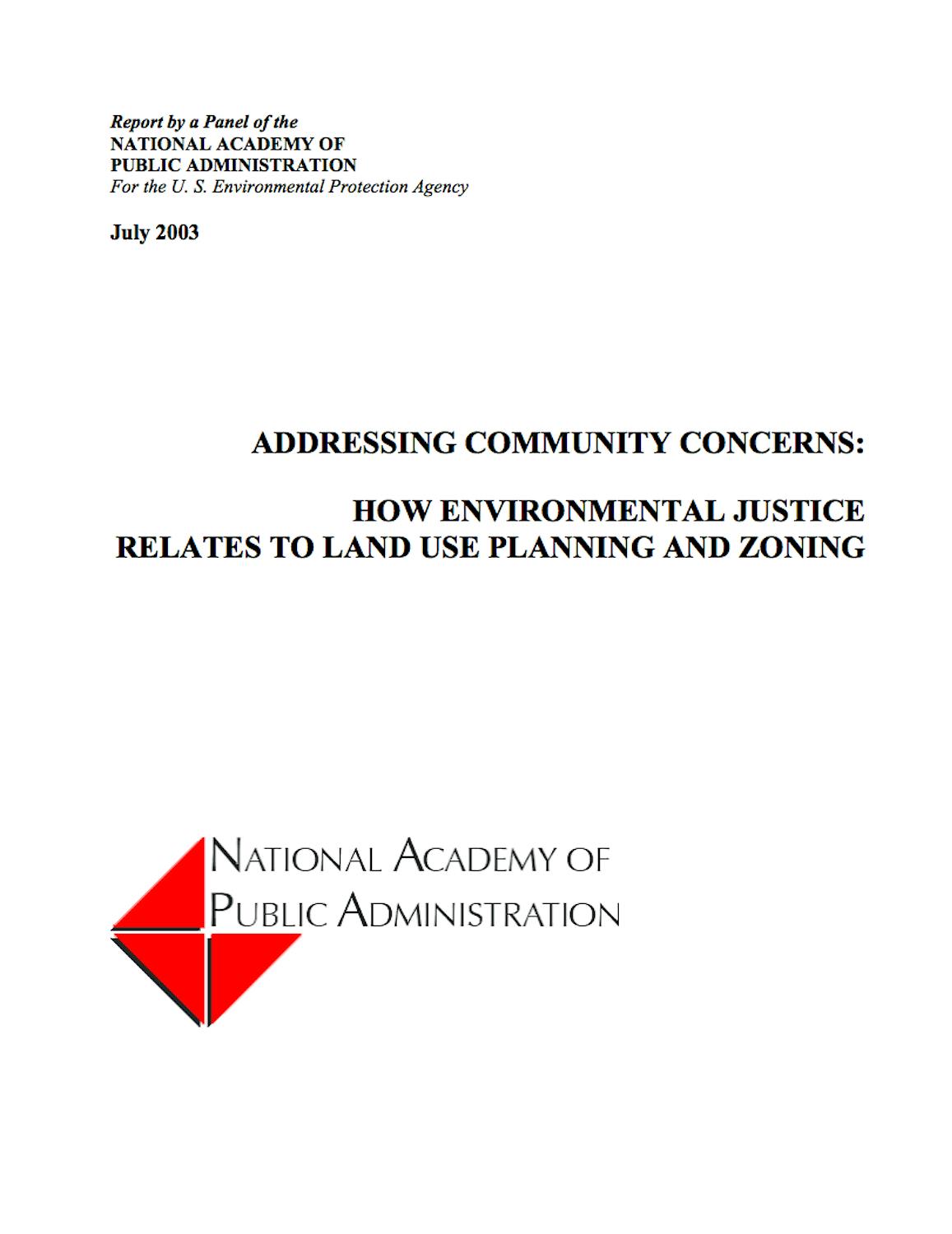
Addressing Community Concerns: How Environmental Justice Relates to Land Use Planning and Zoning
This report is the third in a series of studies on environmental justice conducted by the Academy for the Environmental Protection Agency (EPA) Office of Environmental Justice (OEJ). It builds on the Academy’s two prior studies, Environmental Justice in EPA Permitting: Reducing Pollution in High-Risk Communities (December 2001) and Models for Change: Efforts by Four States to Address Environmental Justice (June 2002).
This study examines the land use planning and zoning laws, policies, and practices of local governments in California, Texas, Pennsylvania, Illinois and Louisiana to determine how they may relate to environmental justice issues.
This third study was designed to help the public understand how land use planning and zoning relate to environmental justice, both in terms of resolving current issues and preventing future problems. It also highlights opportunities for engaging the public in the local planning and zoning decisions that affect their communities.
Click the button below to view the View Study Report.
View ReportKey Findings
All levels of government should conduct thorough examinations of their respective legal and regulatory authorities—including common law authorities for protecting the general welfare of citizens—to develop creative solutions for environmental justice problems.
Federal, state, and local levels of government should work in concert to ensure that their actions for responding to environmental justice issues are compatible and mutually reinforcing. They should share information, coordinate programs, and develop comprehensive rules that will ensure consideration and mitigation of localized environmental and public health impacts, especially in low-income and minority communities.
Recommendations
The Panel’s recommendations, based on the research detailed in the body of this report, can be summarized as follows:
- State and local executive and legislative branches of government must demonstrate leadership to address environmental justice concerns. They should use their full legal authorities to enact appropriate legislation, issue policies, develop guidance, and develop accountability measures to ensure that, at both levels of government, core government functions are authorized and required to address environmental justice. They should also enhance opportunities for meaningful public participation in all government decisions that have environmental and public health impacts; and each level of government should improve public access to information about land use planning, zoning, siting, and permitting.
- All levels of government should conduct thorough examinations of their respective legal and regulatory authorities—including common law authorities for protecting the general welfare of citizens—to develop creative solutions for environmental justice problems.
- Federal, state, and local levels of government should work in concert to ensure that their actions for responding to environmental justice issues are compatible and mutually reinforcing. They should share information, coordinate programs, and develop comprehensive rules that will ensure consideration and mitigation of localized environmental and public health impacts, especially in low-income and people-of-color communities.
- National associations of local governments should disseminate information and offer training on best practices in land use planning and zoning that are currently used by cities and counties to ensure fair treatment, as well as meaningful involvement, of all people in decisions that affect public health and the environment.
- City and county governments should incorporate consideration of potential environmental and public health impacts of land use decisions into the fabric of their planning and zoning activities. They should actively explore how they can use current authorities to prevent excessive levels of pollution and mitigate environmental and other impacts like noise, odor, and traffic—especially in low-income and people-of-color communities.
- State, county, and city officials who are responsible for planning, zoning, public health, and environmental protections should take immediate action to determine whether their residents in low-income and people-of-color neighborhoods are exposed to excessive levels of environmental and health hazards. If so, they should initiate appropriate actions to reduce risks and communicate to the public when and how these risks will be reduced or eliminated.
